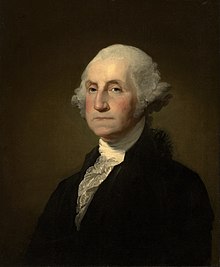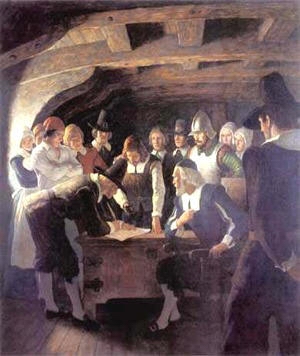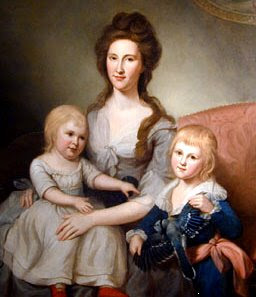 Summary: Washington's time is up and he owes his gratitude to his fellow citizens. In Washington's Farewell Address he stresses that America is built on patriotism that will unite with the "same religion, manners, habits, and political principles. You have in a
common cause fought and triumphed together; the independence and liberty
you possess are the work of joint counsels, and joint efforts of common
dangers, sufferings, and successes." Washington also states that the North, South, East, and West are all connected with commerce and communication between each other which are united together. Washington goes on to talk about the Constitution and that the people have the power to change it at any time. It has the distribution of power, free principles, and is best for the nation, yet will be revised and changed over time from the political parties that will act against each other. Washington warns the nation to try to stay away from foreign influence as this may cause mislead the country and doom them. Washington presents his final goodbye with the most advice and gratitude he could give back to the people. With the statements of unity, national morality, a well developed government, America will become stronger and more united.
Summary: Washington's time is up and he owes his gratitude to his fellow citizens. In Washington's Farewell Address he stresses that America is built on patriotism that will unite with the "same religion, manners, habits, and political principles. You have in a
common cause fought and triumphed together; the independence and liberty
you possess are the work of joint counsels, and joint efforts of common
dangers, sufferings, and successes." Washington also states that the North, South, East, and West are all connected with commerce and communication between each other which are united together. Washington goes on to talk about the Constitution and that the people have the power to change it at any time. It has the distribution of power, free principles, and is best for the nation, yet will be revised and changed over time from the political parties that will act against each other. Washington warns the nation to try to stay away from foreign influence as this may cause mislead the country and doom them. Washington presents his final goodbye with the most advice and gratitude he could give back to the people. With the statements of unity, national morality, a well developed government, America will become stronger and more united. Wednesday, September 26, 2012
LAD #7: Washington's Farewell Address
 Summary: Washington's time is up and he owes his gratitude to his fellow citizens. In Washington's Farewell Address he stresses that America is built on patriotism that will unite with the "same religion, manners, habits, and political principles. You have in a
common cause fought and triumphed together; the independence and liberty
you possess are the work of joint counsels, and joint efforts of common
dangers, sufferings, and successes." Washington also states that the North, South, East, and West are all connected with commerce and communication between each other which are united together. Washington goes on to talk about the Constitution and that the people have the power to change it at any time. It has the distribution of power, free principles, and is best for the nation, yet will be revised and changed over time from the political parties that will act against each other. Washington warns the nation to try to stay away from foreign influence as this may cause mislead the country and doom them. Washington presents his final goodbye with the most advice and gratitude he could give back to the people. With the statements of unity, national morality, a well developed government, America will become stronger and more united.
Summary: Washington's time is up and he owes his gratitude to his fellow citizens. In Washington's Farewell Address he stresses that America is built on patriotism that will unite with the "same religion, manners, habits, and political principles. You have in a
common cause fought and triumphed together; the independence and liberty
you possess are the work of joint counsels, and joint efforts of common
dangers, sufferings, and successes." Washington also states that the North, South, East, and West are all connected with commerce and communication between each other which are united together. Washington goes on to talk about the Constitution and that the people have the power to change it at any time. It has the distribution of power, free principles, and is best for the nation, yet will be revised and changed over time from the political parties that will act against each other. Washington warns the nation to try to stay away from foreign influence as this may cause mislead the country and doom them. Washington presents his final goodbye with the most advice and gratitude he could give back to the people. With the statements of unity, national morality, a well developed government, America will become stronger and more united. LAD #6: Washington's Proclamation of Neutrality
Summary: Austria, Prussia, Sardinia, Great Britain, and the United Netherlands are against France in war. The United States and Washington take the act of The Proclamation of Neutrality of 1793. This proclamation would make them neutral with all the countries from the first sentence. It would be illegal for any citizens to provide help towards any of the countries in war and violate the nations laws. 

Tuesday, September 25, 2012
Republican Motherhood Blog
1. What role did the Revolutionary War play in the transformation of house wifery to Republican Motherhood?
The Revolutionary War shaped women to transform out of their known roles of being in charge of the house to gaining new rights and roles. The men respect the women to gain knowledge and raise the household too. Yet, raising the children to become a patriot is a job, she can gain knowledge to teach the children (Document A). With the duties of being with their husband, education is still important. Knowing English, how to write, bookkeeping, and history is important to pass down to the children (Document B). Home is the comfort zone for women at this time period. It is the boundary for them which many never crossed or conquered. Now, the other side leads to the society that can be changed forever (Document D). It is a barrier never broken before this time period, but little pieces of this wall will fall over time.
2. What were the consequences of Republican Motherhood on women?
This was something that had not been thought of before. Women breaking out of their social home and gaining progress to lead forward. Although, this society has not seen women break out of their normal lifestyle in which chaos will control society (Document D). Yet, having a little freedom for women is acceptable, it is their right place to remain restricted to create a well-ordered family (Document A). The women were given few freedoms, but this society is not ready for the change in lifestyle for women.
3. What is the significance of the ideology of Republican Motherhood as a stage in the process of women's socialization?
Republican Motherhood is the first step in gaining rights for women. Even though it is a tiny step, it is still a step forward. "Religion,
fairest off spring of the skies, smiles auspicious on her endeavors; the Genius
of Liberty hovers triumphant over the glorious scene," (Document C). The women are gaining ground and should be proud of it. They felt it was not their place to be so they stepped up.
Mary Gibson Tilghman and her sons by Charles Wilson Peale (1789)
1. Describe the setting.
It shows the woman, Mary Gibson Tilgham, and her sons. The two sons sit on the lap of the mother who is sitting on the couch.
2. Who serves at the center of the portrait and why? How does the women look? How is she "republican" rather than aristocratic?
The center of the portrait seems to be Mary Gibson Tilgham as she is portraying a modest look as she has more light to her than anything else in the portrait. The woman wears just a plain dress with nothing too fancy on herself. She looks republican and not aristocratic because she wears no make up and has just a regular dress.
3. What values do her sons exhibit?
The son on the left with the blue outfit seems to be wearing a soldiers uniform. This shows he is learning to about the army and maybe the father is not present because he is in battle. The other son in the white outfit wears just plain clothes to show that he resembles the modesty of his mother.
4. Is there a significance to the position of Mrs. Tilghman's arm?
The position of the arm holding back the younger child to the other one shows that she tries to make the children behave and teaches them and guides them to be calm and responsible, the role of the Republican Motherhood.
Monday, September 24, 2012
LAD #5: Federalist #10
1. Why are factions so difficult to eliminate?
"It could never be more truly said than of the first remdy, that it was the worst of the disease." It's difficult to eliminate because people live off of it. With liberty comes political views which fuels the fire of factions. Also, everybody's opinion is different. It is difficult to change everybody's opinions to make it so everybody agrees on one thing. Along with property and wealth can change the influences and interests of different people.
2. If factions cannot be removed then how can they be controlled?
Factions can be controlled by having a less majority, it can have the majority defeat the views of the minority. Causes cannot be controlled, only the effects can. For example, having a democracy with a small amount of people and meet with the government in person can prevent the effects.
Tuesday, September 18, 2012
LAD #4: Revolution Article
5 things I learned after reading this article:
1. 620,000 soldiers died in the Civil War
2. Most people that had lived through the American Revolution had died by the 1820's so there was no pride in the next generation of people
3. Civil War had weapons that could cause more casualties than the Americans in the Revolution
4. One painting from the Revolutionary War was from a battle and no one was firing
5. Washington did not commemorate any of his epic battle wins

1. 620,000 soldiers died in the Civil War
2. Most people that had lived through the American Revolution had died by the 1820's so there was no pride in the next generation of people
3. Civil War had weapons that could cause more casualties than the Americans in the Revolution
4. One painting from the Revolutionary War was from a battle and no one was firing
5. Washington did not commemorate any of his epic battle wins

Sunday, September 16, 2012
LAD #3: Declaration of Independence
1. Democratic Principles: The colonists believed that the British treated them unfairly to an extent that they could not stand it anymore. They no longer wanted a king or a monarchy, but developed the principles of a democracy. They included the freedom that all people have and that each person is equal. They include that the people have the right to change anything about the government based of the majority. They try to get rid of the thought of a king because the monarchy proved to be unjust to the civilians of the colony and they feared it. They also included that they would have "free and independent states". The thought of continuing the monarchy to the colonists would have been torture and they included the king's mistakes for them to part ways.
2. List a handful of grievances: The king's treatment to the colonists was used for the good of Britain, but more unfair to the colonists. The Declaration of Independence includes twenty-eight oppressions against the king. The document includes that king did nothing for the good of the people, kept armies there without the knowing of the legislatures, cutting off trade with other parts of the world, and many more. The people had this right to succeed in creating a better environment for the people. Even though the colonies were used for the benefit of the mother country, they never thought about the determination the colonies had to defeat the British in the American Revolution. With the colonies separating with thoughts of helping the colonists, it created havoc for the two lands.
3. Conclusion: The Americans had the vision to succeed in building a free land without a king and to begin a new government system. The monarchy was ended in the American land to leave behind the hatred against the king's harsh treatment and to start a new beginning with the basics of a democratic system. All decisions are made for the benefit of themselves.

2. List a handful of grievances: The king's treatment to the colonists was used for the good of Britain, but more unfair to the colonists. The Declaration of Independence includes twenty-eight oppressions against the king. The document includes that king did nothing for the good of the people, kept armies there without the knowing of the legislatures, cutting off trade with other parts of the world, and many more. The people had this right to succeed in creating a better environment for the people. Even though the colonies were used for the benefit of the mother country, they never thought about the determination the colonies had to defeat the British in the American Revolution. With the colonies separating with thoughts of helping the colonists, it created havoc for the two lands.
3. Conclusion: The Americans had the vision to succeed in building a free land without a king and to begin a new government system. The monarchy was ended in the American land to leave behind the hatred against the king's harsh treatment and to start a new beginning with the basics of a democratic system. All decisions are made for the benefit of themselves.

Saturday, September 8, 2012
LAD #2: John Peter Zenger
1. Who was John Peter Zenger?
John Peter Zenger was a newspaper writer that worked for the New York Weekly Journal in the early 1730's.
2. What was the controversy over his charges? Talk about Hamilton's defense.
John Peter Zenger accused Governor Cosby for writing false accusations about him. John Peter Zenger's lawyer Andrew Hamilton told the court that statements were made but not false.
3. What influence did his case have on American governmental tradition?
This case influenced the government by them now having to allow criticism from the people which was not allowed before.
4. What is the lasting significance of his trial? Explain.
This case gave free will to the press which meant they could express there thoughts on the government when they weren't allowed to say criticism before.

LAD #1 Mayflower Compact & Fundamental Orders of Connecticut
1) What concepts are included
in the Mayflower Compact?
The concepts in the Mayflower
Compact include having the first colony with fair laws, ordinances, acts,
constitutions, and officers by making a united government.
2) How does the Mayflower
Compact reflect and attachment to both the "Old" and "New"
worlds?
The old world was still loyal
to the king while the new world wanted democracy and independence from the
mother country.
3) How did the Fundamental
Orders of Connecticut differ from the Mayflower Compact?
The Fundamental Orders of
Connecticut gave more power to the people to choose the government and commit
to more equality than the Mayflower Compact.
4) What prompted the
colonists of Connecticut
to take this approach to government, i.e.: use of a written Constitution?
The colonists of Connecticut wanted to
have more power to choose the government and make sure there isn’t too much
power in one person.
5) In what significant way(s)
does the Fundamental Orders reflect a fear of and safeguard against the
usurping of power by one person or a chosen few?
The Fundamental Orders
reflects fear of power by making sure that the governor changes every two years
and to have fairness in the courts by sending people from each town for the
jurisdictions.

Subscribe to:
Comments (Atom)

